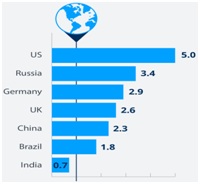Earth Overshoot Day shift back to July 29: WWF
- Posted By
10Pointer
- Categories
Environment
- Published
30th Jul, 2021
-
-
Context
According to the World Wide Fund for Nature (WWF), humanity has again used up all biological resources that Earth regenerated during the entire year by July 29, 2021.
-
Background
- The concept of Earth Overshoot Day was first conceived by Andrew Simms of the UK think tank New Economics Foundation, which partnered with Global Footprint Network in 2006 to launch the first global Earth Overshoot Day campaign.
- The World Wide Fund for Nature (WWF), the world’s largest conservation organization, has participated in Earth Overshoot Day since 2007.
- Under coronavirus lockdowns in 2020, last year's Overshoot Day fell on August 22, nearly a month later than the high of July 25 set in 2018.
|
Greenhouse gases only declined 6.4% in 2020 — a substantial drop representing around twice Japan's yearly emissions.
|
- But this year, even though carbon emissions from air travel and road transport are still lagging 2019 highs, a rallying global economy is pushing emissions and consumption back up.
-
Analysis
What is Earth Overshoot Day?
- Earth Overshoot Day marks the date when humanity’s demand for ecological resources and services in a given year exceeds what Earth can regenerate in that year.
- This deficit is maintained by liquidating stocks of ecological resources and accumulating waste, primarily carbon dioxide in the atmosphere.
- Earth Overshoot Day is hosted and calculated by Global Footprint Network.
- Global Footprint Network is an international research organization that provides decision-makers with a menu of tools to help the human economy operate within Earth’s ecological limits.

-
How is the day determined?
- To determine the date of Earth Overshoot Day for each year, Global Footprint Network calculates the number of days of that year that Earth’s biocapacity suffices to provide for humanity’s Ecological Footprint.
- The remainder of the year corresponds to global overshoot.
- Earth Overshoot Day is computed by dividing the planet’s biocapacity (the amount of ecological resources Earth is able to generate that year), by humanity’s Ecological Footprint (humanity’s demand for that year), and multiplying by 365, the number of days in a year:
|
(Earth’s Biocapacity / Humanity’s Ecological Footprint) x 365 = Earth Overshoot Day
|
-
How many Earths would we need if the world’s population lived like the current pattern?
- Humanity currently uses 74 per cent more than what the planet’s ecosystems can regenerate — or 1.7 Earths.
- From Earth Overshoot Day until the end of the year, humanity operates on ecological deficit spending.
- CO2 emissions related to energy — particularly fossil fuels like coal — are projected to grow by 4.8% this year over 2020 levels, according to the International Energy Agency.

-
Why is it a concern?
- This is worryingly the same date that the world reached two years ago in 2019. This means that the modest gains accrued from the novel coronavirus disease (COVID-19) as far as humanity’s ecological footprint is concerned have been lost.
- This spending was currently some of the largest since the world entered into ecological overshoot in the early 1970s, according to the National Footprint & Biocapacity Accounts based on UN datasets.
-
What are the solutions to add to the Earth’s biocapacity accounty?
- Reforesting: Reforesting an area (the size of India, for example) would shift the date back by eight days.
- Energy-saving technologies: Retrofitting buildings and industries with existing energy-saving technology, such as mechanical system upgrades, water conservation controls and sensors that accurately control lighting, temperature and air quality, would move the date back by 21 days.
- Stoppage on food wastage: Food is another important area, half of the Earth's biocapacity is used just to keep us fed. But too much of that food is lost due to inefficiencies during the production process, or waste.
- An estimated 30 to 40% of food in the US ends up in landfills every year.
- Choosing foods grown with more sustainable agricultural practices less reliant on fossil fuels.
|
Shifting to more plant-based diets, for example, could help reduce food-related emissions as much as 70% by 2050, according to a recent draft report released by the Intergovernmental Panel on Climate Change (IPCC).
|
-
Conclusion
The world missed a significant opportunity of lockdown during pandemic and it continues to miss the opportunities every day by not recognizing the climate and extinction crises as emergencies, just like the pandemic.

